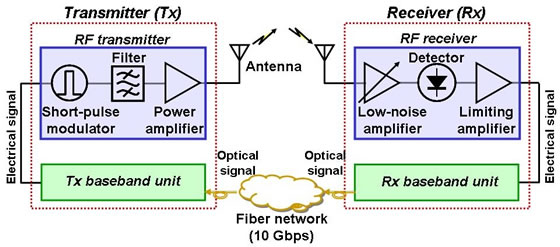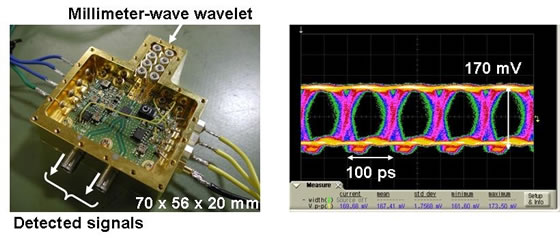Archived content
NOTE: this is an archived page and the content is likely to be out of date.
Fujitsu Achieves World's First Impulse Radio-Based Millimeter-Band Transmissions Exceeding 10 Gbps
- Realizes high-capacity, compact wireless transmission equipment -
Fujitsu Limited,Fujitsu Laboratories Ltd.
Tokyo and Kawasaki, Japan, June 11, 2009
Fujitsu Limited and Fujitsu Laboratories Ltd. today announced the development of the world's first impulse radio(1)-based high-capacity wireless transmission equipment using millimeter-band transmissions in the 70-100 gigahertz (70-100 GHz) range band, resulting in throughput exceeding 10 gigabits-per-second (10 Gbps). This technology dispenses with the oscillators and other components that have been required in conventional wireless transmission technologies, enabling compact and inexpensive millimeter-band transmission equipment. The new technology is suitable as an alternative to fiber-optic trunk lines in regions where those lines would be difficult to lay, as a way to bridge the digital divide(2), and can also be used for ultra-fast wireless LANs.
This research was conducted as part of the Research and Development Project for Expansion of Radio Spectrum Resources sponsored by Japan's Ministry of Internal Affairs and Communications. Details of this technology were presented at the 2009 IEEE MTT-S International Microwave Symposium (IMS 2009) being held in Boston from June 7 to June 12.
Background
To accommodate the growing appetite for bandwidth on the Internet and on wireless networks, there is a global effort underway to lay high-capacity fiber-optic trunk lines. For those regions where it is difficult to lay fiber-optic lines, wireless equipment that operates at 10 Gbps - on par with fiber-optic cable - has been considered as a way to bridge the digital divide.
For wireless transmissions at speeds exceeding 10 Gbps, it is best to use the 70-100 GHz millimeter band, as it is relatively easy to secure wide swaths of bandwidth and is thus suitable for long-distance transmissions. However, equipment that operates at these high frequencies requires the use of multiple, single-purpose electronic components, resulting in a high parts count - there has been minimal progress on miniaturizing the equipment and reducing its cost. This has made impulse radio an attractive option for development, as it obviates the need for bulky oscillators and other components, resulting in compact and inexpensive hardware.
Technological Challenges
In an impulse radio transceiver (Figure 1), there is a RF(3) transmitter consisting of three components: a short-pulse(4) modulator, a filter, and a power amplifier; and a RF receiver consisting of a low-noise amplifier, detector, and limiting amplifier. Last year, Fujitsu and Fujitsu Laboratories co-developed the world's first RF transmitter, excluding the power amplifier, and subsequently began work on developing transmission equipment that includes a RF receiver intended for transmission testing. However, in order to send and receive millimeter-band pulse signals using an impulse radio, the following issues - which do not appear in conventional transmission methods - had to be overcome:
- On the receiving side, waveform distortions - introduced into the signal by the wiring path from the antenna to the amplifier - need to be reduced, and the minute millimeter-band signals need to be faithfully amplified.
- On the sending side, the millimeter-band pulse signal sent from the transmitter has a propensity towards time variations. At the receiving end, this can lead to slippage on the determination of a millimeter-band pulse as being a 0 or 1, resulting in faulty reception. Therefore, the time variation needs to be minimized.
 Figure 1: Impulse-radio millimeter-band transceiver
Figure 1: Impulse-radio millimeter-band transceiver
Larger View (217 KB)
Overview of Newly-Developed Technology
To address the aforementioned issues, Fujitsu and Fujitsu Laboratories developed the following technologies based on its indium-phosphide high electron mobility transistor (InP HEMT)(5).
- Broadband and high-sensitivity receiving technology (receiver)
Using the InP HEMT, which offers higher speeds and lower noise than conventional gallium-arsenide HEMTs, a broadband, high-gain, low-noise amplifier was developed. This low-noise amplifier is connected to the receiving antenna by an interconnect that has the reverse transmission characteristics of the low-noise amplifier, so that waveform distortions introduced by the interconnect cancel each other out, resulting in a signal waveform that is close to the form it was received as.
- High-stability short-pulse modulation technology (transmitter)
The time variation in the sent signal is attributable to timing jitter, of the timing of short-pulse generation in the short-pulse modulator. In particular, generating a short pulse from a 10 Gbps data signal with significant timing jitter will make the time variation very conspicuous. Fujitsu Laboratories used a new circuit for the InP HEMT short-pulse generator, that generates a short pulse based on a 10 GHz clock signal, which has minimal jitter compared to the 10 Gbps data signal, while referencing the 10 Gbps data signal.
Results
Impulse-radio millimeter-band transmission equipment was developed using the aforementioned technologies, which included a baseband unit with a fiber-optic interface. The receiver had a sensitivity of 0.25 microwatts (0.25 µW), and along with the sensitivity needed for kilometer-class wireless transmissions, was demonstrated to achieve good received waveforms (Figure 2). The transmitter held jitter on a 10 Gbps millimeter-band pulse signal to 0.3 picoseconds(6), an improvement of more than fivefold over the level of stability achieved in 2008. Indoor transmission testing with a paired transmitter and receiver resulted in the world's first wireless transmissions to exceed 10 Gbps using impulse radio in the millimeter band.
 Figure 2: New impulse-radio RF receiver (left) and measurement results of 10 Gbps-reception waveform (right)(Y axis: output voltage; X axis: time)
Figure 2: New impulse-radio RF receiver (left) and measurement results of 10 Gbps-reception waveform (right)(Y axis: output voltage; X axis: time)
Larger View (158 KB)
Dispensing with oscillators and mixers which are required in conventional technologies makes millimeter-band transmitters more compact and less costly. This technology can be used as an alternative to fiber-optic networks, to provide a trunk-line equivalent to bridge the digital divide. In addition, it can be used for a wide range of potential applications, including indoor ultra-fast wireless LANs and high-resolution radar.
Future Developments
Fujitsu will begin field testing this new technology with the aim of developing commercial systems by around 2012.
About Fujitsu
Fujitsu is a leading provider of IT-based business solutions for the global marketplace. With approximately 175,000 employees supporting customers in 70 countries, Fujitsu combines a worldwide corps of systems and services experts with highly reliable computing and communications products and advanced microelectronics to deliver added value to customers. Headquartered in Tokyo, Fujitsu Limited (TSE:6702) reported consolidated revenues of 4.6 trillion yen (US$47 billion) for the fiscal year ended March 31, 2009. For more information, please see: www.fujitsu.com.
About Fujitsu Laboratories
Founded in 1968 as a wholly owned subsidiary of Fujitsu Limited, Fujitsu Laboratories Limited is one of the premier research centers in the world. With a global network of laboratories in Japan, China, the United States and Europe, the organization conducts a wide range of basic and applied research in the areas of Multimedia, Personal Systems, Network, Peripherals, Advanced Materials and Electronic Devices. For more information, please see: http://jp.fujitsu.com/labs/en/
Press Contacts
Public and Investor Relations Division
Inquiries
Company:Fujitsu Limited
Technical Contacts
Advanced Devices Lab.
Devices & Materials Lab.
 Phone: +81(46)250-8244
Phone: +81(46)250-8244
 E-mail: kikan-press@ml.labs.fujitsu.com
E-mail: kikan-press@ml.labs.fujitsu.com
Company:Fujitsu Laboratories Ltd.
Company and product names referenced herein are trademarks or registered trademarks of their respective owners. Information provided in this press release is accurate at time of issue and is subject to change without advance notice.
Date: 11 June, 2009
City: Tokyo and Kawasaki, Japan
Company:
Fujitsu Limited,
Fujitsu Laboratories Ltd.,
,
,
,
![]() Phone: +81(46)250-8244
Phone: +81(46)250-8244![]() E-mail: kikan-press@ml.labs.fujitsu.com
E-mail: kikan-press@ml.labs.fujitsu.com
